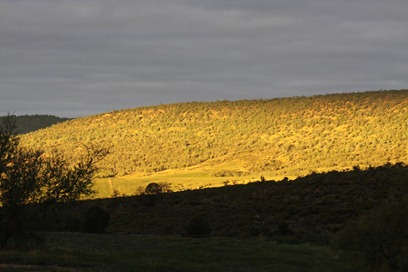 From Arkaroola we drove to Marree via Copley. This tested Trish's packing for dirt roads. We have been pleased that so far it has stood up successfully and we haven't found the biscuits reduced to crumbs or the oil all over the cupboard.
From Arkaroola we drove to Marree via Copley. This tested Trish's packing for dirt roads. We have been pleased that so far it has stood up successfully and we haven't found the biscuits reduced to crumbs or the oil all over the cupboard.
Marree was known as Hergotts Crossing until WW1 when anti-German sentiment saw the name changed. Marree means place of many possums. It is the intersection of the Birdsville Track and the Oodnadatta Track. 
For a while it was the rail head for the Ghan Express train. Later when the line went to Alice Springs the track's gauge width changed here [don't ask - it is an Australian thing!!] it was where one was woken up in the middle of the night to get onto a narrower or broader gauge train.
People who endured that journey say it was a nightmare, but at least the hotel did a roaring trade as all the passengers had to leave the train. Marree declined when the train line relocated west.

 The Oasis Caravan Park is basic but offers a $10 barbecue. For that you get a mixed grill and dessert of apple strudel and vanilla slice, cooking like Nonna used to make courtesy of two Italian backpacker girls who along with a visiting station owner who had flown from Bellingen to see Lake Eyre, provided the evenings entertainment of poetry and singing. This was a great evening.
The Oasis Caravan Park is basic but offers a $10 barbecue. For that you get a mixed grill and dessert of apple strudel and vanilla slice, cooking like Nonna used to make courtesy of two Italian backpacker girls who along with a visiting station owner who had flown from Bellingen to see Lake Eyre, provided the evenings entertainment of poetry and singing. This was a great evening.  It was here we first saw what must be an outback phenomenon of circling of the wagons, where even with space to spare, people parked as close as possible and then surrounded their vans with vehicles. We are not sure which predator was of concern.
It was here we first saw what must be an outback phenomenon of circling of the wagons, where even with space to spare, people parked as close as possible and then surrounded their vans with vehicles. We are not sure which predator was of concern. 

 The next day we flew over Lake Eyre. It really is a fantastic sight, with water. Lake Eyre is the worlds largest internally draining system. Normally it is a salt pan. It fills infrequently mostly from floods in Queensland this year from floods in the Georgina River. When it fills it is a mecca for birds and humans. Because the floods came late in the season less birds came to breed, although the air was quite busy with flights from Marree, William Creek, Birdsville and elsewhere.
The next day we flew over Lake Eyre. It really is a fantastic sight, with water. Lake Eyre is the worlds largest internally draining system. Normally it is a salt pan. It fills infrequently mostly from floods in Queensland this year from floods in the Georgina River. When it fills it is a mecca for birds and humans. Because the floods came late in the season less birds came to breed, although the air was quite busy with flights from Marree, William Creek, Birdsville and elsewhere.
Maree alone averaged thirty departures a day.
The Lake Eyre Yacht Club at Marree is a triumph of optimism. The Commodore had a two week cruise this year.
We also flew over the Marree Man, a 4.2 km tall man ploughed into the desert, making him the world's largest artwork. 
There is a great deal of speculation about the originator of this Artwork and theories abound. Some believe it was the Americans then based at Woomera because they had access to GPS tracking, although this seems unlikely as they would have found it hard to have 3 months of spare time required to do the plowing.
A former policeman we met in Coober Pedy believes it was a local "bushie" from the Roxby Downs area, rich enough to have a bulldozer and GPS, but it seems unlikely the truth will ever be known.











 From Wilpena we drove to Blinman and then towards Leigh Creek.
From Wilpena we drove to Blinman and then towards Leigh Creek.





























 We enjoyed Argadells as it was bush camping with hot showers. The Juetts were very hospitable. We had fire rings and could cook camp oven roasts which we like to do. The Iron rings round the fires were thick and transmitted heat so we could toast our feet with a relatively small fire. John believes this photo should be called "Lamb roasting by/on the fire"
We enjoyed Argadells as it was bush camping with hot showers. The Juetts were very hospitable. We had fire rings and could cook camp oven roasts which we like to do. The Iron rings round the fires were thick and transmitted heat so we could toast our feet with a relatively small fire. John believes this photo should be called "Lamb roasting by/on the fire"






![NEW - THE MAPS [By Popular Request]](http://1.bp.blogspot.com/-Vajyd8kXoSk/TtvtX94QV7I/AAAAAAAAEBk/0MJEoH3UojI/s187/Around%2BAustralia.jpg)